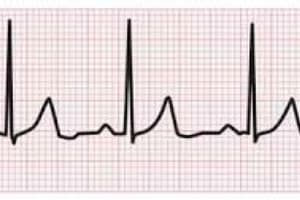Podcast
Questions and Answers
What does the abbreviation ECG stand for?
What does the abbreviation ECG stand for?
- Electroencephalograph (correct)
- Electromyogram
- Electrocardiogram
- Electrocardiograph
What is the time duration represented by one small square on an ECG paper?
What is the time duration represented by one small square on an ECG paper?
- 0.2 seconds
- 0.1 seconds
- 1 second
- 0.04 seconds (correct)
Which of the following is NOT a function of an ECG?
Which of the following is NOT a function of an ECG?
- Identify conduction problems
- Determine the heart's rhythm
- Detect heart muscle damage
- Measure blood pressure (correct)
What is the electrical potential represented by ten small squares on an ECG paper?
What is the electrical potential represented by ten small squares on an ECG paper?
What is the primary function of the electrodes used in ECG?
What is the primary function of the electrodes used in ECG?
What is the significance of the 'P wave' in an ECG?
What is the significance of the 'P wave' in an ECG?
Which of the following components of an ECG is used to determine the duration of ventricular depolarization?
Which of the following components of an ECG is used to determine the duration of ventricular depolarization?
What is the primary advantage of using a 12-lead ECG system?
What is the primary advantage of using a 12-lead ECG system?
Which of the following is NOT a typical characteristic of a normal ECG?
Which of the following is NOT a typical characteristic of a normal ECG?
Why is the speed of paper movement in an ECG set at 25 mm per second?
Why is the speed of paper movement in an ECG set at 25 mm per second?
Flashcards
ECG
ECG
Recording of electrical activity of the heart on graph paper.
Electrocardiography
Electrocardiography
The process of creating an ECG recording.
Significance of ECG
Significance of ECG
Provides information about heart rate, rhythm, and conditions.
ECG paper dimensions
ECG paper dimensions
Signup and view all the flashcards
Speed of ECG machine
Speed of ECG machine
Signup and view all the flashcards
Small square time interval
Small square time interval
Signup and view all the flashcards
Voltage on ECG paper
Voltage on ECG paper
Signup and view all the flashcards
Waveforms in ECG
Waveforms in ECG
Signup and view all the flashcards
ECG leads
ECG leads
Signup and view all the flashcards
Normal ECG
Normal ECG
Signup and view all the flashcards
Study Notes
Electrocardiogram (ECG)
- ECG is the recording of the electrical activity of the heart on a graph paper.
- Alternatively, it's a graphical representation of the heart's electrical activity.
- ECG is an acronym for ElectroCardioGraphy.
- The word originates from:
- Electro (Greek for electricity)
- Cardio (Greek for heart)
- Graph (Greek root meaning "to write")
Heart Conduction System
- The heart's electrical activity is depicted by the ECG.
- Components of the system include:
- SA Node
- Interatrial Pathways
- AV Node
- Bundle of His
- Bundle Branches
- Purkinje Fibers
Significance of ECG
- ECG provides information about the heart rate and rhythm.
- It aids in diagnosing various heart conditions like:
- Hypertrophy
- Ischemia
- Infarction
- Arrhythmias
- Conduction problems
- Pacemaker activity
- However, ECG does not assess mechanical activity of the heart.
ECG Paper
- ECG paper is a long strip of paper with small squares.
- Each square measures 1mm by 1mm.
- Thick lines, called major divisions separate smaller squares.
- Five small squares sit between major divisions on ECG paper.
- The speed of the ECG machine is 25mm per second.
- The time duration of one small square on the ECG paper is 0.04 seconds.
ECG Paper Dimensions
- One millimetre (mm) horizontally represents 0.04 seconds.
- One millimetre (mm) vertically represents 0.1 millivolts (mV).
- Horizontally, 5mm = 0.20 seconds.
ECG Waves and Intervals
- The electrical activity is characterized by five primary wave deflections (P, Q, R, S, and T), which represent different stages of the heart's cycle.
- Various segments (e.g., PR, ST) and intervals (e.g., PR, QT) between these waves also provide diagnostic detail.
ECG Leads
- Leads are electrodes that record the electrical potential of the heart at different sites.
- There are 12 ECG leads:
- 3 Bipolar Limb Leads (e.g., I, II, III)
- 3 Augmented Limb Leads (e.g., aVR, aVL, aVF)
- 6 Chest Leads (V1 to V6)
Anatomical Groups of Leads
- Leads are categorized by their anatomical location on the heart these group leads into:
- Inferior leads
- Septal leads
- Anterior leads
- Lateral leads
Examples of ECG Rhythms
- Normal Sinus Rhythm, Ventricular Tachycardia, Ventricular Fibrillation, ST Elevation and ST Depression
Studying That Suits You
Use AI to generate personalized quizzes and flashcards to suit your learning preferences.




